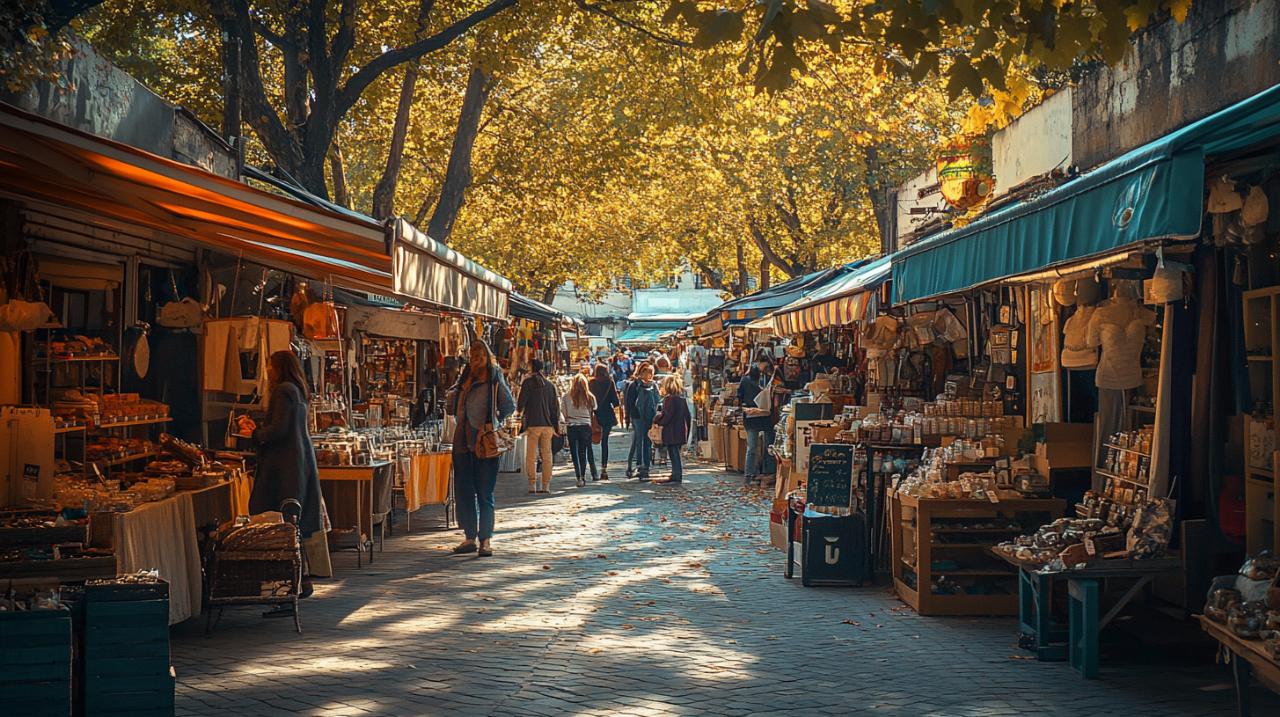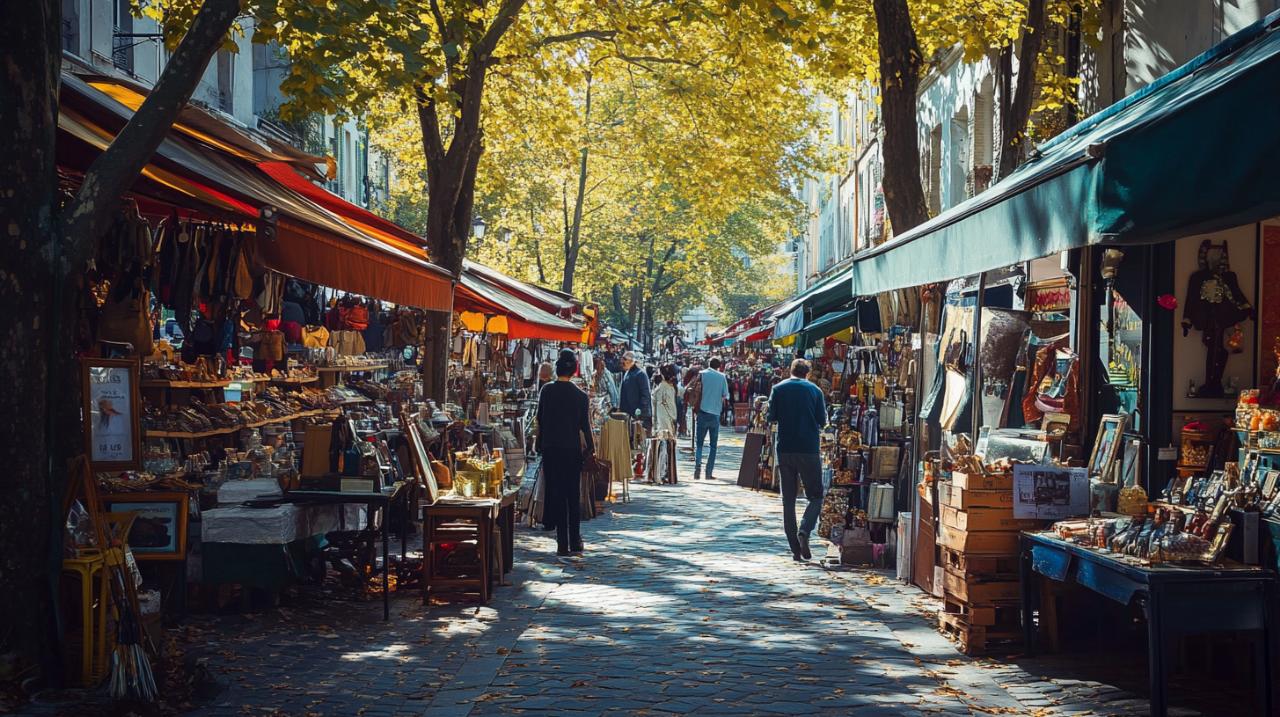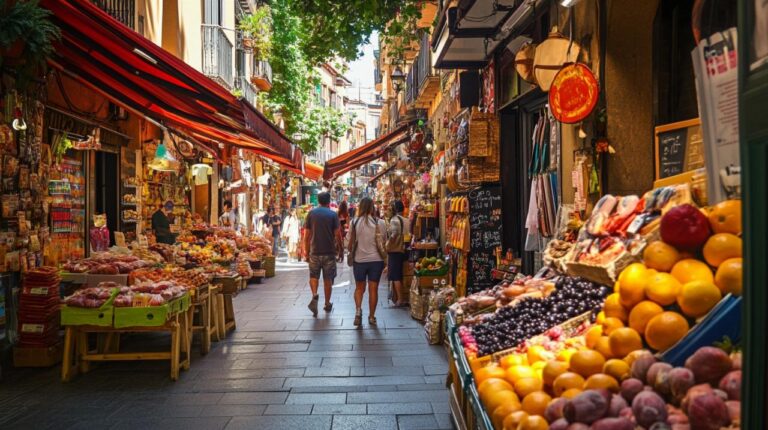The Clignancourt Flea Market, nestled in the charming commune of Saint-Ouen just beyond the northern edges of Paris, offers a shopping adventure quite unlike any other. This sprawling treasure trove, officially known as Les Puces de Saint-Ouen, draws countless visitors each weekend with its unparalleled collection of antiques, vintage clothing, and collectables. Whether you’re a seasoned collector or a curious explorer, the market’s bustling alleys and hidden corners promise discoveries that range from the delightfully affordable to the breathtakingly exquisite.
Navigating the Treasures of Clignancourt: A Shopper’s Paradise
Stepping into Clignancourt feels akin to entering a labyrinth of history and style, where every turn reveals another facet of Parisian charm. The market sprawls across approximately seven hectares, encompassing over 3,000 vendor boutiques, stalls, and showrooms. This vast expanse is divided into fourteen distinct markets, each boasting its own character and specialities. From the elegant galleries of Biron to the eclectic offerings of Vernaison, the diversity on display ensures that every visitor can find something that speaks to their tastes. The sheer scale of the market can be overwhelming at first, but with a bit of planning and a sense of adventure, you’ll soon find yourself immersed in a world where the past and present collide in the most delightful ways. Enthusiasts of vintage fashion will revel in the racks of clothing that span decades, while those with an eye for furniture can admire everything from ornate armoires to sleek mid-century modern pieces. The market also caters to collectors of fine art, jewellery, and curiosities, making it a true shopper’s paradise.
Understanding the Market Layout and Best Routes
Getting to grips with the layout of Clignancourt is essential for making the most of your visit. The market is conveniently accessible via Metro Line 4 to Porte de Clignancourt or Metro Line 13 to Garibaldi, with additional bus and tram connections ensuring that public transport is both straightforward and efficient. Upon arrival, the main thoroughfare to follow is Rue des Rosiers, which serves as the backbone of the market and leads you through its various districts. Each of the fourteen markets within Les Puces has its own entrance and ambience, so it’s worth taking a moment to orientate yourself before diving in. For instance, Marché Vernaison, one of the oldest sections, is known for its labyrinthine alleys filled with vintage finds and quirky collectables. Meanwhile, Marché Biron, established in 1925, attracts those seeking high-end antiques and fine art. The Dauphine market offers a more contemporary vibe with its mix of vintage and modern items, while Paul Bert is celebrated for its selection of industrial and rustic pieces. Taking the time to explore these different areas will reward you with a richer and more varied experience. Many visitors recommend starting early on a Saturday or Sunday when the majority of stalls are open, allowing you to wander at a leisurely pace and truly absorb the atmosphere. As you navigate the market, keep an eye out for the smaller, less conspicuous stalls tucked away in corners, as these often harbour the most unexpected treasures. The tiendahoy blog has highlighted the importance of such exploration, noting that the joy of Clignancourt lies as much in the journey as in the finds themselves.
Top stalls and speciality dealers worth visiting
While the entire market is a feast for the senses, certain stalls and dealers have earned reputations for their exceptional offerings. Marché Biron, for example, is home to dealers who specialise in luxury items such as Jean Elysee Puiforcat solid silver centrepieces and Lalique square vases, with prices reflecting their exquisite craftsmanship and historical significance. These pieces are not merely objects but stories of artistry and elegance, often accompanied by certificates of authenticity and provenance. For those with a more modest budget, Marché Vernaison and Marché Paul Bert provide a wealth of affordable yet charming items, from vintage jewellery to quirky collectables. The vendors here are often passionate about their wares and eager to share the history behind each piece, making the shopping experience both educational and enjoyable. If contemporary vintage is more your style, the Dauphine market offers a curated selection of twentieth-century design, including furniture and decorative arts that blend seamlessly into modern interiors. The market also hosts special events such as the Flea Festival, which brings together dealers and visitors for a celebration of all things vintage and antique. Professional shippers are available on site, offering services to help transport larger purchases back home, which is particularly useful for international visitors or those acquiring bulky items. This level of convenience underscores the market’s commitment to providing a comprehensive and hassle-free shopping experience.
Making the Most of Your Clignancourt Visit: Practical Tips and Insider Secrets

To truly unlock the potential of your visit to Clignancourt, a little preparation and insider knowledge can go a long way. The market’s reputation as the world’s largest antiques market is well deserved, attracting between 120,000 and 180,000 visitors each weekend. This popularity means that while the atmosphere is vibrant and bustling, it also requires a strategic approach to ensure you don’t miss out on the best deals and hidden gems. Understanding the rhythms of the market, from the optimal times to visit to the art of negotiation, will enhance your experience and leave you with both treasured finds and fond memories.
Essential shopping strategies and bargaining techniques
Bargaining is an integral part of the Clignancourt experience, and mastering this art can lead to significant savings and a more engaging interaction with vendors. Most dealers expect a degree of negotiation, with discounts of 10 to 20 percent being entirely reasonable, especially if you’re purchasing multiple items. The key is to approach the process with respect and a sense of playfulness, treating it as a game rather than a confrontation. One effective strategy is to work in pairs, where one person expresses interest while the other remains somewhat sceptical, creating a dynamic that can encourage the vendor to lower the price. Taking your time to consider a purchase also signals to the dealer that you are a serious buyer, which can work in your favour. It’s important to remember that the vendors at Clignancourt are professionals who take pride in their collections, so genuine appreciation for their wares will often be met with goodwill and flexibility. Another insider tip is to visit smaller, less crowded markets such as Marché d’Aligre, Vanves, or Montreuil if you’re seeking more affordable bargains. However, for the sheer variety and quality that Clignancourt offers, the main market remains unmatched. As you browse, keep your valuables secure and be mindful of pickpockets, a common concern in crowded areas. A discreet bag or money belt will allow you to focus on the treasures around you without worry. Many visitors also recommend carrying cash, as some smaller vendors may not accept card payments, and having the exact change can facilitate smoother transactions.
When to Visit and What to Bring for a Successful Hunt
Timing your visit to Clignancourt can significantly impact your experience. The market is open every Saturday from 9am to 6pm, Sundays from 10am to 6pm, and Mondays from 11am to 5pm, though it’s worth noting that many stalls may close around lunchtime on Mondays. Saturday and Sunday are the busiest days, with the greatest number of dealers present, making them ideal for those who want to see the market in full swing. If you prefer a quieter atmosphere, an early Saturday morning arrival allows you to beat the crowds and have first pick of the day’s offerings. Fridays are less commonly busy, with limited opening times from 10am to 1pm, but this can be a good option for serious collectors seeking a more intimate browsing experience. When preparing for your visit, consider bringing a sturdy bag or trolley for carrying purchases, as well as a bottle of water and comfortable shoes, since you’ll be spending several hours on your feet exploring the market’s many winding paths. A notebook or smartphone is also useful for jotting down stall numbers or taking photos of items you’re considering, allowing you to compare prices and make informed decisions. The market’s rich history, dating back to 1885 when the authorities of Saint-Ouen paved the streets and formalised the area, adds an extra layer of intrigue to your visit. The origins of Les Puces can be traced even further, with informal trading beginning around 1870, and this sense of continuity and tradition is palpable as you wander through the stalls. Whether you’re hunting for a Jean Campa geometric sculpture, a vintage pharmacy corkscrew, or simply soaking up the vibrant atmosphere, Clignancourt offers an experience that is as much about the journey as the destination. The market’s commitment to preserving its heritage while embracing contemporary tastes ensures that it remains a beloved institution for both locals and tourists alike.





